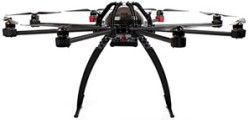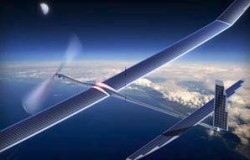Anatech Electronics Newsletter - February 2016 |
|
Anatech Electronics, a manufacturer of RF and microwave filters, has published its February 2016 newsletter. As always, it includes both company news and some tidbits about relevant industry happenings. This month, Sam Benzacar's main thesis addresses the public nuisance that multirotor 'drones' have become in the hands of stupid and/or ignorant pilots. Multicopters: The Next Interference Issue?
Now that the price of consumer multicopters (aka multirotors) has fallen and more manufacturers make them, they were a big hit for holiday shoppers. While some of these "drones' cost less than $1,000 they can cost more than $12,000 for those with truly impressive payload capacities. While radio-controlled planes and helicopters have been around for ages, they were mostly the domain of hobbyists and relatively few in number, so interference wasn't an issue. But the obvious appeal of being able to fly your own miniature aircraft at altitudes up to about 400 feet with still image capture and HD video streaming conjures up plenty of uses, from legitimate ones to privacy invasion, and if you let your mind wander, even carrying payloads other than cameras. The old adage that "wherever there's smoke there's fire" applies to applications of RF and microwave technology as well, and this new one offers innumerable opportunities for interference both to the drone and from it, especially once they've become more numerous. Almost all use Wi-Fi for communication with the controller (although some use 433 MHz) and to a smartphone app, which makes sense as there is more than enough bandwidth available at 2.4 GHz for delivery of video. As Wi-Fi offers spread-spectrum modulation (frequency-hopping) and is designed to operate alongside other services like Bluetooth operating in the ISM band, interference "shouldn't" be an issue. I said shouldn't because conversations I've had with friends who own multicopters have shed some light on the subject. As these little aircraft travel around an area, they can be exposed to everything from outdoor Wi-Fi hotspots, notoriously-leaky cable distribution amplifiers, high-and low-voltage power lines, and possibly both the macro and small cells of wireless carriers. Some of these "fliers" noted that what they suspect is interference sometimes causes the control link to fail, usually only briefly, but not always. The result can range from destruction of an expensive toy to flying into people on the way down. In fact, the first reported case of a drone crashing because of RF interference occurred last March in Australia, when an Aeronavics SkyJib 8 being used to bolster media coverage of the International Cricket Council World Cup Final at the Melbourne Cricket Ground lost communication with the controller and crashed. Fortunately, none of the many spectators were injured. The cause, which was investigated by the Australian Traffic Safety Bureau, was determined to be RF interference, most likely because there were was so much radio traffic at the event. I think it's safe to say that as more and more drones take to the air the number of interference-related drone accidents will substantially increase, some causing injuries. Even though even the least-expensive drones have to meet FCC guidelines for interference, a lot of them won't. So keep your eyes on the sky. On a brighter note, if you're experiencing interference problems in systems you're developing or those already deployed, RF and microwave filters are still the best solution --and your best resource is Anatech Electronics. So please give us a call at (973) 772-4242 or send an email to sales@anatechelectronics.com. What's News Google's Latest Aerial Internet Scheme
Congress May Ramp up EW Funding
Lt. Gen. Ben Hodges told Defense News that he finds Russian EW technology "eye-watering", with the ability to effectively jam communication, radar, and GPS signals. Former Army EW division chief Laurie Buckhout told the publication that "we have great signals intelligence, and we can listen all day long, but we can't shut them down one-tenth to the degree they can us. We are very unprotected from their attacks on our network." Wireless: Behind the Scenes at Super Bowl 50
Microwave Heating System Uses 500-W GaN Modules Mitsubishi Electric, Tokyo Institute of Technology, Ryukoku University and Microwave Chemical Co have developed a microwave heating system that uses 500-W gallium nitride (GaN) RF power amplifier modules as heat sources. It reportedly consumes 70% less energy than conventional external fossil fuel heating systems and improves chemical-reaction productivity by three times. Practical uses will now be developed for energy saving in the chemical industry. External heating systems consume lots of power because they need to heat both the equipment and the chemicals inside, while the internal microwave-based system just heats the chemicals. It also controls phase to manage temperature distribution, which increases the efficiency of the chemical reaction. About Anatech Electronics Anatech Electronics, Inc. (AEI) specializes in the design and manufacture of standard and custom RF and microwave filters and other passive components and subsystems employed in commercial, industrial, and aerospace and applications. Products are available from an operating frequency range of 10 kHz to 30 GHz and include cavity, ceramic, crystal, LC, and surface acoustic wave (SAW), as well as power combiners/dividers, duplexers and diplexers, directional couplers, terminations, attenuators, circulators, EMI filters, and lightning arrestors. The company's custom products and capabilities are available at www.anatechelectronics.com. Contact: Anatech Electronics, Inc.
Posted February 18, 2016 |

 By Sam Benzacar
By Sam Benzacar
 Not satisfied with its balloon-borne plan to provide Internet access, Google is now
testing solar-powered drones at Spaceport America in New Mexico under a program called Project SkyBender. The "optionally
piloted" Centaur and solar-powered drones are made by Google Titan (formed when Google bought Titan Aerospace). Google is
using 15,000 sq. ft. of hangar space at the Gateway to Space terminal destined for Virgin Galactic spaceflights. The drones
are controlled via communications systems operating at 28 GHz, which neatly coincides with might be used for "5G" wireless
networks. Google ultimately believes thousands of these high-altitude aircraft could be used to deliver Internet access
around the world. To compensate for the short ranges possible at millimeter-wave frequencies, phased-array antennas and
other techniques are required.
Not satisfied with its balloon-borne plan to provide Internet access, Google is now
testing solar-powered drones at Spaceport America in New Mexico under a program called Project SkyBender. The "optionally
piloted" Centaur and solar-powered drones are made by Google Titan (formed when Google bought Titan Aerospace). Google is
using 15,000 sq. ft. of hangar space at the Gateway to Space terminal destined for Virgin Galactic spaceflights. The drones
are controlled via communications systems operating at 28 GHz, which neatly coincides with might be used for "5G" wireless
networks. Google ultimately believes thousands of these high-altitude aircraft could be used to deliver Internet access
around the world. To compensate for the short ranges possible at millimeter-wave frequencies, phased-array antennas and
other techniques are required.  Congress is reportedly working on legislation
that would allow the Pentagon to increase funding for electronic warfare technology and system development. The impetus
for this is the "revelation" that after years of complacency, DoD and especially the Army have allowed U.S. EW capabilities
to fall behind. The bill aims to give DoD greater flexibility in how money is spent for EW. Col. Jeffrey Church, chief of
the Army's electronic warfare division "the technology is out there right now. We can go to industry. We can go to the government,
off the shelf. Often times, people forget but I say, ‘What do you think the Russians are using? Make-believe technology?
No, it's there."
Congress is reportedly working on legislation
that would allow the Pentagon to increase funding for electronic warfare technology and system development. The impetus
for this is the "revelation" that after years of complacency, DoD and especially the Army have allowed U.S. EW capabilities
to fall behind. The bill aims to give DoD greater flexibility in how money is spent for EW. Col. Jeffrey Church, chief of
the Army's electronic warfare division "the technology is out there right now. We can go to industry. We can go to the government,
off the shelf. Often times, people forget but I say, ‘What do you think the Russians are using? Make-believe technology?
No, it's there." Levi's Stadium in Santa Clara, CA, boasts one the most comprehensive distributed antenna
system (DAS) and Wi-Fi capabilities of any venue in the world – including an interesting smartphone app. It was subjected
to its biggest test at the Super Bowl. With a huge network of beacons throughout the stadium that provide location capability,
under-seat Wi-Fi access points, and 1,200 total access points, the system handled the traffic, which was two and a half
times that of last year's event. The entire initial system, constructed when the stadium was built, was ripped out and replaced
to accommodate the Super Bowl. The upgrade, which was paid for by the wireless carriers, included an increase in Verizon
sectors from 60 to 80 and AT&T sectors from 45 to 60, coverage sectors in the main seating area increasing from 23 to
40, antennas from 250 to 400, and remotes from 330 to 450, among other enhancements. The app allows attendees to find their
way through the stadium via Bluetooth beacons, watch instant replays, and order food by seat number.
Levi's Stadium in Santa Clara, CA, boasts one the most comprehensive distributed antenna
system (DAS) and Wi-Fi capabilities of any venue in the world – including an interesting smartphone app. It was subjected
to its biggest test at the Super Bowl. With a huge network of beacons throughout the stadium that provide location capability,
under-seat Wi-Fi access points, and 1,200 total access points, the system handled the traffic, which was two and a half
times that of last year's event. The entire initial system, constructed when the stadium was built, was ripped out and replaced
to accommodate the Super Bowl. The upgrade, which was paid for by the wireless carriers, included an increase in Verizon
sectors from 60 to 80 and AT&T sectors from 45 to 60, coverage sectors in the main seating area increasing from 23 to
40, antennas from 250 to 400, and remotes from 330 to 450, among other enhancements. The app allows attendees to find their
way through the stadium via Bluetooth beacons, watch instant replays, and order food by seat number.